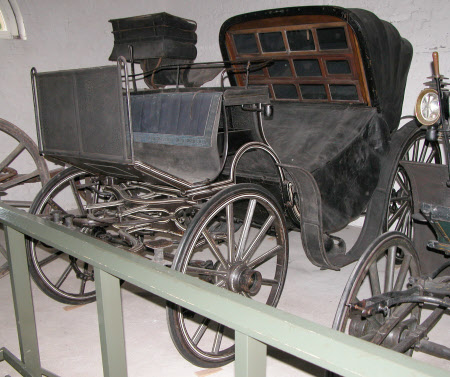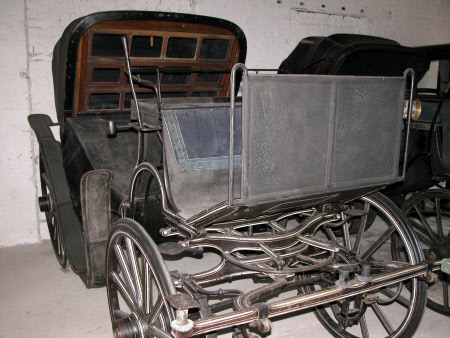Victoria
Cook, Rowley & Co.
Category
Carriages & other vehicles
Date
circa 1860
Materials
Painted wood body with leather hood, wool cloth upholstery and four rubber shod tyres.
Measurements
205 x 345 x 160cm (6ft 8 3/4in x 11ft 3 3/4in x 5ft 3in)
Place of origin
London
Order this imageCollection
Erddig, Wrexham
NT 1152604
Caption
Victoria carriages come in a variety of sizes and shapes. This example is a Skeleton Boot Victoria, the lighter more elegant version and one where the drivers seat can be folded away so that the carriage can be driven by its owner rather than a coachman. This carriage is very unusual in that it has a gkazed screen protecting the passengers. Victorias are usually open carriages. A screen such as the one seen here is usually seen on a carriage called a Britzschka which was used for long distance travelling.
Summary
Carriage. Skeleton Boot Victoria built in 1860 by Cook, Rowley & Co, London. Skeleton Boot Victoria (four wheels) for a single or pair of horses. This carriage has a cut under body of curved profile and is sprung on double inverted ‘C’ springs. It has a leather hood and a glazed screen of twelve windows in the head frame. There are two candle lamps. The interior is upholstered in blue wool cloth. Painted in a livery of black with sham canework to the body and white lining.
Full description
This is a very attractive Skeleton Boot Victoria with pretty cut-under body with imitation cane-work on the body panels. It has two very unusual and interesting features, suspension on inverted double ‘C’ springs and a folding screen or shutter of small glass windows that fits into a frame in the hood front. The fixed frame and framework of the screen are varnished mahogany. The screen consists of three rows of four windows, all of which are fixed except the two end ones of the middle row which hinge open. A screen of this sort was usually fitted on a Britzschka, which was used for long journeys, but it is unusual to find one on a Victoria. Victorias were popular in the late 19th century, particularly with ladies, the low body providing easy access for them in the full dresses then worn. Although essentially open carriages, they have a folding leather head over the principal seat. Victorias were coachman-driven, with a groom beside him, and could be pulled by a single horse or a pair. It is difficult to fit a brake satisfactorily to a carriage with a body hung on leather braces from C springs, so a drag shoe is fitted, which is placed under the nearside hind wheel to brake it when going down hill, and hung under the carriage when not in use.
Provenance
Given by Philip Yorke III (1905-1978) along with the estate, house and contents to the National Trust in 1973.
Marks and inscriptions
On nearside side panel on applied oval bosses.: Y On offside side panel on applied oval bosses.: Y On front nearside axle cap.: COOK, ROWLEY & CO LONDON On front offside axle cap.: COOK, ROWLEY & CO LONDON On rear nearside axle cap.: COOK, ROWLEY & CO LONDON On rear offside axle cap.: COOK, ROWLEY & CO LONDON
Makers and roles
Cook, Rowley & Co., coach builder

